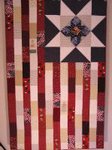Updated 3/2017-- photos and all links (except to my own posts) removed
as many are no longer active and it was easier than checking each one.
The latest edition of the Aesthetic Surgery Journal (Sept/Oct 2010) has a really nice article (first reference below) on this tuberous breasts. One of the best things about the article is the great photos, both of the deformity (includes this one to the right) and the corrective procedure.
Another nice thing the article has is the review of the breast’s embryology which is critical to understanding the formation of the deformity (bold emphasis is mine).
The breast originates from the mammary ridge, which develops in utero from the ectoderm during the fifth week. Shortly after its formation (in the seventh to eighth weeks), most parts of this ridge disappear, except for a small portion in the thoracic region, which persists and penetrates the underlying mesenchyme around 10 to 14 weeks. Further differentiation and development of the breast occurs during the intrauterine life and is completed by the time of birth, after which essentially no further development occurs until puberty.
During puberty, the mammary tissue beneath the areola grows with enlargement of the areola, until the age of 15 to 16, when the breast assumes its familiar shape. As a result of the ectodermal origin of the breast and its invagination into the underlying mesenchyme, the breast tissue is contained within a fascial envelope, the superficial fascia. This superficial fascia is continuous with the superficial abdominal fascia of Camper and consists of two layers: the superficial layer (which is the outer layer covering the breast parenchyma) and the deep layer (which forms the posterior boundary of the breast parenchyma and lies on the deep fascia of the pectoralis major and serratus anterior muscles). The deep layer of the superficial fascia is penetrated by fibrous attachments (suspensory ligaments of Cooper), joining the two layers of the superficial fascia and extending to the dermis of the overlying skin and the deep pectoral fascia. Of note is that the superficial layer of this fascia is absent in the area underneath the areola, as can easily be demonstrated by the invagination of the mammary bud in the mesenchyme.
Clinical experience has shown us and other authors that in cases of tuberous breasts, there is a constricting fibrous ring at the level of the periphery of the nipple-areolar complex that inhibits the normal development of the breast. This constricting ring of fibrous tissue is denser at the lower part of the breast and does not allow the developing breast parenchyma to expand during puberty. Histology confirmed the existence of such dense fibrous tissue in the area of this “constricting ring.” Specimens from two of our patients have been examined, and they showed large concentrations of collagen and elastic fibers, arranged longitudinally. We believe this ring represents a thickening of the superficial fascia, as described earlier. Perhaps the two layers of this fascia join at a higher level than usual, or the suspensory ligaments are thicker and more dense.
Tuberous breast deformity is a rare condition that becomes apparent during teenage years as the breast develop. As noted in the embryology description, the deformity is due to a constricting fibrous ring which does not allow the breast to form in a normal shape.
The deformity which was first described in 1976 by Rees and Aston, can be either unilaterally or bilaterally. When bilateral, the deformity may be vary in degree. It has many other names: tubular breasts, Snoopy breasts, herniated areolar complex, domed nipple, nipple breast, constricted breast, lower pole hypoplasia, and narrow-based breast.
A common classification of tuberous breast deformity is the one proposed by Grolleau et al (photo credit):
-
Type I: deficiency of the lower medial quadrant. (A)
-
Type II: deficiency of both lower quadrants. (B)
-
Type III: deficiency of all four quadrants. (C,D)
The only way to correct this deformity is surgery. Even if no implant is needed or desired, the nipple/areolar complex benefits from a periareolar donut-type skin excision, reducing the areola to the desired size, usually 4 to 4.5 cm in diameter.
I agree with the authors that the constricting fibrous ring needs to be divided so the breast parenchyma can assume a more natural shape. When an implant is used, the subglandular or duel-plane position is preferred.
I would encourage reading the full article for more tips.
REFERENCES
Aesthetic Reconstruction of the Tuberous Breast Deformity: A 10-Year Experience; Mandrekas AD, Zambacos GJ;
Aesthetic Surgery Journal September/October 2010 30: 680-692, doi:10.1177/1090820X10383397
The tuberous breast; Rees TD, Aston SJ; Clinics of Plastic Surgery 1976;3:339-347.
Breast Base Anomalies: Treatment Strategy for Tuberous Breasts, Minor Deformities, and Asymmetry; Grolleau, Jean-Louis; Lanfrey, Etienne; Lavigne, Bruno; Chavoin, Jean-Pierre; Costagliola, Michel; Plastic & Reconstructive Surgery. 104(7):2040-2048, December 1999.
Aesthetic Reconstruction of the Tuberous Breast Deformity; Mandrekas, Apostolos D.; Zambacos, George J.; Anastasopoulos, Anastasios; Hapsas, Dimitrios; Lambrinaki, Nektaria; Ioannidou-Mouzaka, Lydia; Plastic & Reconstructive Surgery. 112(4):1099-1108, September 15, 2003.


















